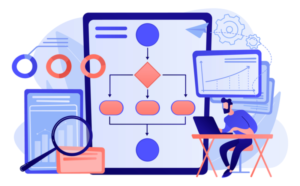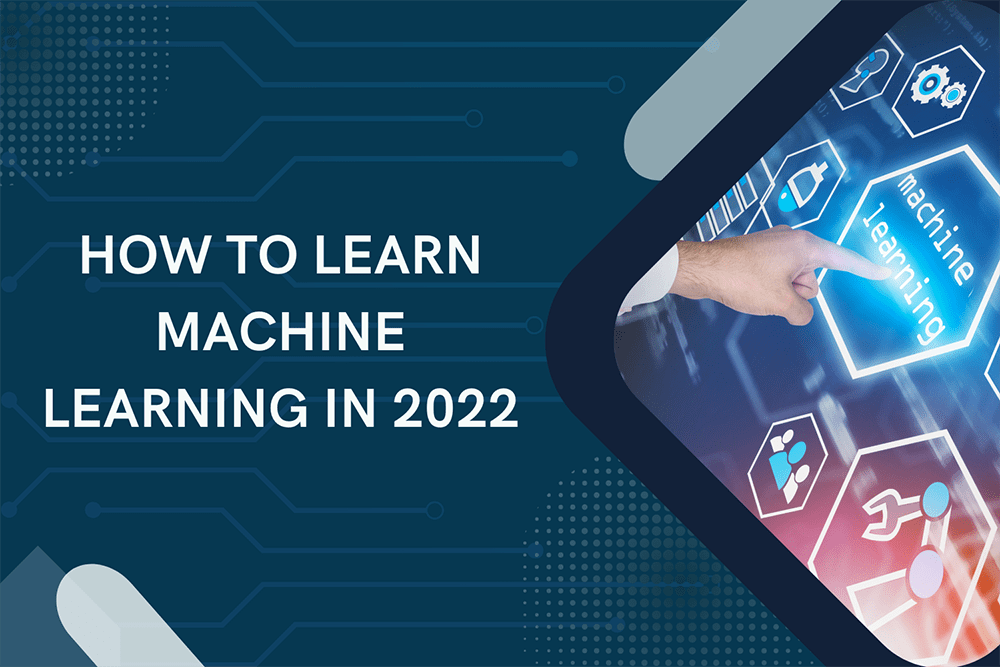Machine learning, in particular, is a thriving and fast expanding discipline with enormous potential for improvement.
In this post, the steps for How to learn machine learning in 2022 is explained.
Following are the steps you need to follow in order to learn machine learning:

Step 1: Learn the Prerequisites:
Before you can grasp machine learning theory and applications, you must first comprehend its fundamental principles. By building a structured learning route, this foundation will help you master ML fundamentals more rapidly.
Start with basic Programming:
All machine learning algorithms are written in code. As a result, every prospective ML engineer must have programming abilities in Python, R, Bash, or Java. Python has emerged as the most popular programming language in recent years, particularly among newcomers. It offers a straightforward syntax, a large number of built-in functions, the most widely supported libraries, and robust package support.
If you’ve never programmed before, a beginning or crash course in Python is the easiest approach to get started with ML. After you’ve learned the basics, you’ll need to learn how to extract, process, and analyse data. Most machine learning and data science courses will include a component on efficient data analysis.
Statistics and Probability:
Statistics and probability are important topics in the ML sector since machine learning professionals deal nearly entirely with data and its predictions. All data-driven judgments are ultimately based on the likelihood of compound events occurring. And descriptive statistics allow raw data to be transformed into useful information that may be utilised to construct and develop ML systems.
Statistics and probability encompass all of the measurements and techniques required to evaluate the connections between data distributions. A thorough study of these disciplines provides you with an intuitive comprehension of regression models based on frequentist statistical theory (for smaller data sets) or contemporary machine learning theory (for larger data sets).
Mathematics:
Linear algebra and calculus are both essential components of machine learning. The techniques used to edit datasets are based on linear algebra, namely vector spaces and matrix operations. Linear algebra also includes important topics like as linear transformations, tensor and tensor rank, notations, and matrix multiplication.
While all prospective ML experts must have a basic comprehension of mathematics, larger projects demand more in-depth principles. If you’re just starting off, you might want to put off learning some of the more advanced calculus subjects. In any case, you’ll need to be familiar with important calculus topics such as gradient and slope, integration and differentiation, partial derivatives, and multivariable operations.
Data Tackling:
Finally, you’ll need to develop expertise working with enormous amounts of data. If you can manage data, you can considerably increase the memory and time consumption of your code. You must clean your data (data wrangling) and estimate the structure of the entire set before you can create or pick a model for data analysis.
A thorough grasp of data modelling functions can assist you in avoiding any problems and blunders in the future. It will also allow you to create better and quicker algorithms for optimizing processing. As you have a better understanding of the nature of the data and the patterns to be discovered, you may begin exploring with more sophisticated ideas such as predictive modelling and analytics.
Step 2: Learn ML Theory till End:
Data Collections:
Begin any ML/AI project by planning the kind of events you will detect and the information you will collect. In most cases, the procedure begins with gathering a modest quantity of training data that may be used to confirm the results in a proof of concept. Before data collection and validation can begin, both continuous (status) and discrete (trigger) events must be clearly established.
Data Assumptions:
To make predictions, all machine learning models make certain assumptions. Linear regression, logistic regression, decision trees, random forests, KNN (K-Nearest Neighbors), support vector machines (SVM), and many other machine learning models are founded on fundamental axioms or assumptions about the structure and behavior of data. The link between the independent and dependent variables, their distribution, multicollinearity, autocorrelation, and outliers are all common data assumptions.
Data Preprocessing:
As the name implies, preprocessing is the process of preparing raw data for processing by a machine learning model. It comprises particular methods to alter or encode the data so that the computer can readily parse it. By reducing input noise, missing values, and system handling mistakes or unacceptable formats, data preparation increases the accuracy and efficiency of the ML model. Preprocessing procedures also detail how to divide the dataset into training and test sets.
Data Integration and Results:
In machine learning, model interpretation aims to comprehend the model’s decision-making process. It carefully assesses the model’s fairness, dependability, trustworthiness, and causation. Simply said, it aids in answering queries such as “How reliable are the model’s predictions?” and “Are they trustworthy enough to influence significant policies and decisions?” Model-specific/model-agnostic techniques and local/global scope methods are the two basic strategies to understand ML models.
Improving the models:
Enhancing the accuracy of the ML model is critical to the overall success of the project. Predictions from the model must have a limited error range and work well with varied issue factors. While some approaches focus on cleaning and filtering the data more effectively, others advocate for employing a variety of ways to improve the model’s performance using fresh, underused data. Cross-validation, feature engineering, and algorithm/hyperparameter adjustment are typical methods for improving model accuracy.
Step 3: Deeply learn the essential topics:
You will begin to appreciate the capabilities and logic behind machine learning models once you have understood the basic ideas. The final stage before you can start contributing to the ML/AI community is to comprehend the sequence of operations in data science from beginning to end. This will help you understand how the data, machine learning, and software code pipelines interact to generate a finished output.
Practice on the ML Workflows:
The machine learning pipeline, strictly speaking, begins with clean, filtered data that has been tuned for ML processing. In fact, ML professionals also spend a significant amount of effort wrangling data to ensure that missing or noisy data does not impair the accuracy of the model. The preliminary code for the model may be generated when the data has been correctly separated into training and test sets. Model engineering, assessment, and packing are all included.
The model assessment stage decides the model decision by using performance criteria like as accuracy and recall. The “prototype” step of the process is completed as the model is trained and developed over time. The workflow subsequently moves to the “production” step, when the model is put into action.
The final stage is to assess the model’s performance by tracking its predictions and assessing the insights gained.
Work on Real Datasets:
Because all genuine data is incorrect in some way, it gives an ideal chance to learn about the common challenges and solutions related with data modification. Thousands of open-source aggregated datasets are accessible to the public thanks to the wonderful ML community.
To utilize for your project, you may readily access computer vision data, climate change data, biological datasets, government databases, geographical/geospatial data, and even FBI crime data. If you are new to data manipulation, you may choose to start with a smaller dataset or select the most relevant information from a bigger dataset. Make sure the dataset you chose is appropriate for beginners—it should include high-quality data that is consistently labelled.
Step 4: Work on Big Projects:
Once you get familiar with the machine learning environment, its now time to work on big ML projects and become an expert. You can work on projects like Sentiment analysis, Stock Price Prediction, Recommendation systems, and many more.


